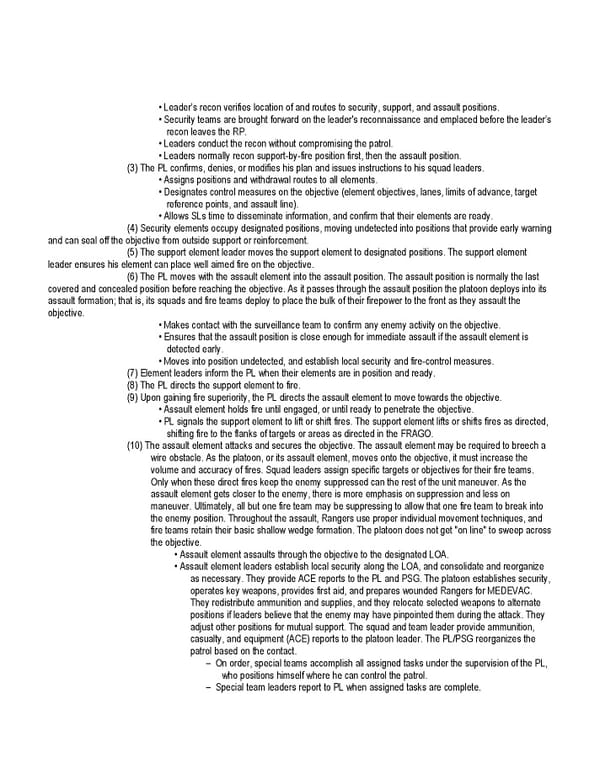• Leader’s recon verifies location of and routes to security, support, and assault positions. • Security teams are brought forward on the leader's reconnaissance and emplaced before the leader’s recon leaves the RP. • Leaders conduct the recon without compromising the patrol. • Leaders normally recon support-by-fire position first, then the assault position. (3) The PL confirms, denies, or modifies his plan and issues instructions to his squad leaders. • Assigns positions and withdrawal routes to all elements. • Designates control measures on the objective (element objectives, lanes, limits of advance, target reference points, and assault line). • Allows SLs time to disseminate information, and confirm that their elements are ready. (4) Security elements occupy designated positions, moving undetected into positions that provide early warning and can seal off the objective from outside support or reinforcement. (5) The support element leader moves the support element to designated positions. The support element leader ensures his element can place well aimed fire on the objective. (6) The PL moves with the assault element into the assault position. The assault position is normally the last covered and concealed position before reaching the objective. As it passes through the assault position the platoon deploys into its assault formation; that is, its squads and fire teams deploy to place the bulk of their firepower to the front as they assault the objective. • Makes contact with the surveillance team to confirm any enemy activity on the objective. • Ensures that the assault position is close enough for immediate assault if the assault element is detected early. • Moves into position undetected, and establish local security and fire-control measures. (7) Element leaders inform the PL when their elements are in position and ready. (8) The PL directs the support element to fire. (9) Upon gaining fire superiority, the PL directs the assault element to move towards the objective. • Assault element holds fire until engaged, or until ready to penetrate the objective. • PL signals the support element to lift or shift fires. The support element lifts or shifts fires as directed, shifting fire to the flanks of targets or areas as directed in the FRAGO. (10) The assault element attacks and secures the objective. The assault element may be required to breech a wire obstacle. As the platoon, or its assault element, moves onto the objective, it must increase the volume and accuracy of fires. Squad leaders assign specific targets or objectives for their fire teams. Only when these direct fires keep the enemy suppressed can the rest of the unit maneuver. As the assault element gets closer to the enemy, there is more emphasis on suppression and less on maneuver. Ultimately, all but one fire team may be suppressing to allow that one fire team to break into the enemy position. Throughout the assault, Rangers use proper individual movement techniques, and fire teams retain their basic shallow wedge formation. The platoon does not get "on line" to sweep across the objective. • Assault element assaults through the objective to the designated LOA. • Assault element leaders establish local security along the LOA, and consolidate and reorganize as necessary. They provide ACE reports to the PL and PSG. The platoon establishes security, operates key weapons, provides first aid, and prepares wounded Rangers for MEDEVAC. They redistribute ammunition and supplies, and they relocate selected weapons to alternate positions if leaders believe that the enemy may have pinpointed them during the attack. They adjust other positions for mutual support. The squad and team leader provide ammunition, casualty, and equipment (ACE) reports to the platoon leader. The PL/PSG reorganizes the patrol based on the contact. – On order, special teams accomplish all assigned tasks under the supervision of the PL, who positions himself where he can control the patrol. – Special team leaders report to PL when assigned tasks are complete.
 Ranger Handbook Page 127 Page 129
Ranger Handbook Page 127 Page 129